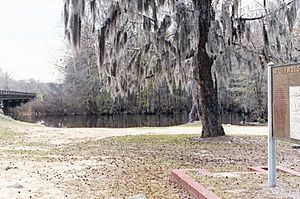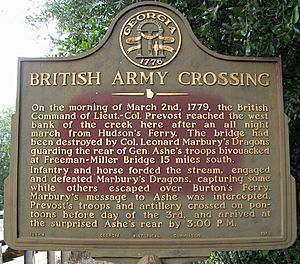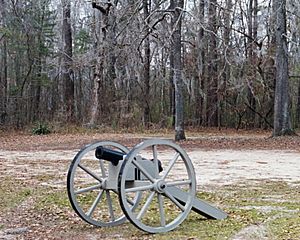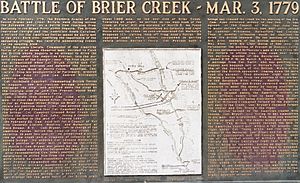Battle of Brier Creek facts for kids
Quick facts for kids Battle of Brier Creek |
|||||||
|---|---|---|---|---|---|---|---|
| Part of the American Revolutionary War | |||||||
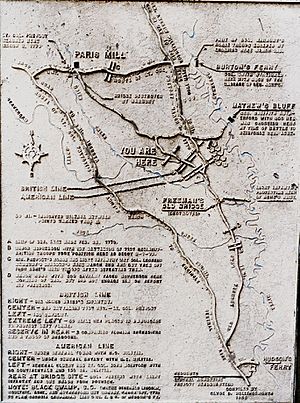 Map from the Georgia State Historical Marker. Created by Clyde D. Hollingsworth, it shows the movements of British and Patriot forces along the Savannah River and Brier Creek. |
|||||||
|
|||||||
| Belligerents | |||||||
| Commanders and leaders | |||||||
| John Ashe Samuel Elbert (POW) |
Mark Prevost | ||||||
| Strength | |||||||
| 1,100 infantry and militia | 900 infantry, cavalry, grenadiers, and militia | ||||||
| Casualties and losses | |||||||
| at least 150 killed, unknown wounded, 227 captured |
5 killed, 11 wounded |
||||||
The Battle of Brier Creek was an important fight during the American Revolutionary War. It happened on March 3, 1779, in eastern Georgia. American forces, mostly made up of citizen soldiers called militia, were surprised by British troops. The Americans suffered many losses. This battle took place just a few weeks after the Americans won a big victory at Kettle Creek. The loss at Brier Creek lowered the spirits of the American Patriots.
Contents
Why the Battle Happened
The American Revolutionary War was a fight for independence. After France joined the war in 1778, the British changed their plan. They decided to focus on the American South. They believed there were more people loyal to Britain there.
British Take Over Augusta
The British sent soldiers to capture Savannah, Georgia. They succeeded on December 29, 1778. Then, British General Augustine Prevost took command. He sent Lieutenant Colonel Archibald Campbell to take Augusta. Campbell also wanted to find and recruit Loyalists. Loyalists were American colonists who supported the British King.
Campbell arrived near Augusta with over 1,000 men. American General Andrew Williamson had about 1,000 militia defending Augusta. But Williamson pulled most of his men back. Campbell then started asking Loyalists to join his army. About 1,100 men signed up, but few actually formed fighting groups.
Campbell was worried about a large American force coming. This force was led by General John Ashe. Ashe had over 1,000 North Carolina militia. So, Campbell decided to leave Augusta on February 12. Two days later, a Loyalist force was defeated at the Battle of Kettle Creek. Campbell did not know about this defeat until after he left Augusta.
Campbell Leaves Augusta
Campbell marched his troops south towards Savannah. He burned the bridge over Brier Creek on the way. At a place called Ebenezer, Campbell gave command to General Prevost's younger brother, Lieutenant Colonel Mark Prevost. Campbell then went back to England.
General Ashe followed Campbell's army. On February 26, Ashe set up camp near Brier Creek. This was about 15 miles (24 km) north of Ebenezer. Ashe's men began fixing the burned bridge. About 200 cavalry and infantry joined Ashe. This made his force about 1,300 men strong.
The Area Around Brier Creek
Brier Creek is a waterway in eastern Georgia. It flows for about 80 miles (130 km). The creek is usually 30 to 50 feet (9 to 16 meters) wide. Near where it meets the Savannah River, it can be 80 feet (25 meters) wide.
The land around Brier Creek and the Savannah River is often swampy. This makes it hard to move around. The meeting point of the creek and river creates a triangle of land. This geography played a big part in where the battle happened.
Before the Battle
General Ashe's camp location was not very good. It had the creek and swamps behind it. This meant his men could easily get trapped. Ashe's assistant, William Bryan, saw this problem. When Ashe left camp on February 28, Bryan moved the camp. He moved it about one mile (1.6 km) north, closer to the Savannah River. Ashe returned to camp on March 2.
British Plan to Surprise the Americans
Colonel Prevost decided to use a plan Campbell had made. This plan was to make a big loop. The British would cross Brier Creek further north. Then they would march south. Their goal was to trap Ashe's men on the land between the creek and the river. A small group of British soldiers would pretend to attack the burned bridge. This would distract Ashe's men.
On March 1, the decoy group of about 500 men marched openly. They camped three miles (4.8 km) from the burned bridge. That night, about 900 experienced British soldiers began a fast march north. This main force included soldiers from the 71st Regiment and light infantry. They also had five cannons.
They reached the Paris Mill bridge around 10:00 am the next morning. The bridge was destroyed, so they built a temporary one. Prevost sent some light infantry and cavalry across the river. They acted as a screen to keep the main force a secret. They also blocked Ashe's escape route. Prevost's entire force crossed the river by dawn on March 3. Ashe's patrols might have known about the British movement, but he did not prepare for an attack.
The Battle
On the afternoon of March 3, a rider rushed into the American camp. He warned them that the British were coming. The Americans had to get ready very quickly. About 900 American soldiers formed their lines. Some men were away scouting or guarding the burned bridge. Giving out ammunition was hard because they did not have enough cartridge boxes. Also, their muskets were different sizes.
When the American lines were ready, Brier Creek was on their left. But there was a big gap on their right side, between their line and the river. The left side was held by North Carolina soldiers. The middle was held by Georgia militia and regular soldiers under Samuel Elbert. The right side was mostly North Carolina soldiers.
Prevost's British troops came forward in three groups. The light infantry was on the left. The 71st Regiment was in the middle. Carolina soldiers and "rangers" were on the right. Prevost kept his cavalry and grenadiers ready as backup.
Both sides started shooting from far away. Then Elbert's men moved forward to get closer. Two things happened that created a gap in the American line. Elbert's men moved to the left as they advanced. This partly blocked the fire from the North Carolina soldiers. Also, British cavalry threatened the American right side. This made the North Carolina soldiers on the right move away from the center.
Seeing this opening, Prevost ordered his men to fix their bayonets and charge. Most of the American militia did not have bayonets. When they saw the British charging, many of them ran away without even firing a shot. The North Carolina soldiers on the right fired a few shots, then they also ran. Elbert's regular soldiers in the middle held their ground. But the militia around them fled into the swamps. Elbert's men were surrounded, and he had to surrender. About 200 American soldiers who were at the bridge arrived late. They quickly left before getting caught in the chaos.
After the Battle
The British had very few losses: 5 killed and 11 wounded. The number of American losses was never fully known. Many militia members ran all the way back to North Carolina. An unknown number drowned in the swamps. Prevost said that 150 American bodies were found. He also said 227 Americans were captured. Most of these were Elbert's regular soldiers.
General Ashe was seen riding after the fleeing militia. Many people blamed him for the disaster. They often said he led the retreat. A military court later cleared him of being a coward. But they did find him guilty of not securing his camp properly.
The Battle of Brier Creek stopped American efforts to push the British out of Georgia. It made sure the British controlled the area. Some historians believe this loss made the war last longer. It also allowed the British to invade South Carolina in 1780. Georgia became a British colony again from 1779 to 1782.
The battlefield was recognized as a historic place in 2020.
Images for kids
-
This is a digital scan of a 1953 'Christmas Card' mailed by Clyde D. Hollingsworth to various recipients in and about Screven County, Georgia. The map included in the mailed 'Christmas Card' is a simplified version of the map displayed on the Georgia State historical marker describing the actions of the various forces engaged in the battle.


